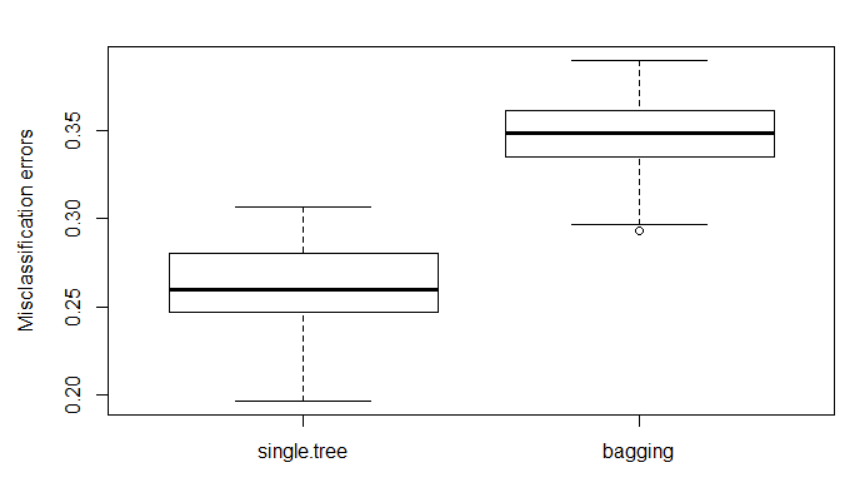Why is the error rate from bagging trees much higher than that from a single tree?
I cross-post this question here, but it seems to me that I'm unlikely to receive any answer. So I post it here.
I'm running the classification method Bagging Tree (Bootstrap Aggregation) and compare the misclassification error rate with one from one single tree. We expect that the result from bagging tree is better then that from one single tree, i.e. error rate from bagging is lower than that of single tree.
I repeat the whole procedure M = 100 times (each time splitting randomly the original data set into a training set and a test set) to obtain 100 test errors and bagging test errors (use a for loop). Then I use boxplots to compare the distributions of these two types of errors.
# Loading package and data
library(rpart)
library(boot)
library(mlbench)
data(PimaIndiansDiabetes)
# Initialization
n <- 768
ntrain <- 468
ntest <- 300
B <- 100
M <- 100
single.tree.error <- vector(length = M)
bagging.error <- vector(length = M)
# Define statistic
estim.pred <- function(a.sample, vector.of.indices)
{
current.train <- a.sample[vector.of.indices, ]
current.fitted.model <- rpart(diabetes ~ ., data = current.train, method = "class")
predict(current.fitted.model, test.set, type = "class")
}
for (j in 1:M)
{
# Split the data into test/train sets
train.idx <- sample(1:n, ntrain, replace = FALSE)
train.set <- PimaIndiansDiabetes[train.idx, ]
test.set <- PimaIndiansDiabetes[-train.idx, ]
# Train a direct tree model
fitted.tree <- rpart(diabetes ~ ., data = train.set, method = "class")
pred.test <- predict(fitted.tree, test.set, type = "class")
single.tree.error[j] <- mean(pred.test != test.set$diabetes)
# Bootstrap estimates
res.boot = boot(train.set, estim.pred, B)
pred.boot <- vector(length = ntest)
for (i in 1:ntest)
{
pred.boot[i] <- ifelse (mean(res.boot$t[, i] == "pos") >= 0.5, "pos", "neg")
}
bagging.error[j] <- mean(pred.boot != test.set$diabetes)
}
boxplot(single.tree.error, bagging.error, ylab = "Misclassification errors", names = c("single.tree", "bagging"))
The result is
Could you please explain why the error rate for bagging trees is much higher than that of a single tree? I feel that this does not make sense. I've checked my code but could not found anything unusual.
I've received an answer from https://stats.stackexchange.com/questions/452882/why-is-the-error-rate-from-bagging-trees-much-higher-than-that-from-a-single-tre. I posted it here to close this question and for future visitors.
- Determining as to whether the function call is stored in a variable
- How to increase resolution of ggplots without using ggsave in officer?
- How to apply a function within a for loop for a set of existing variables of a predifined structure in R?
- How to change the number of decimal places of the mean in a data frame
- Forestplot in R superscript in tabletext matrix
- Converting colnames from character to numeric when extracting them from a dataframe
- With different seeds can Random States repeat in R
- How to Stack Painted Phylogenetic Trees in R Like ggdensitree but with Colored Regimes
- How to import/rbind multiple files with different indexed columns?
- Pivot wider in R return list instead of data frame
- R workspace doesn't load anything in Visual Studio Code
- Search for multiple occurrences of substring within string
- Looking for faster way to implement logSumExp across multidimensional array
- How to get \bm{} to work in an R markdown (to HTML) file?
- Leaving a space in geom_bar with stat='bin', position='dodge' and zeroes
- Where are the 1st stage F statistics located in a "fixest" object?
- Collapsing data per family
- How to set default template for new ".R" files in rstudio
- Adding two-way fixed effects for zero inflated Poisson model
- How to Move R Code and Output to the Right in a Quarto PDF Document?
- What does runif() mean when used inside if_else()?
- Remove columns from dataframe where ALL values are NA
- How to pass unquoted argument to filter() within user defined function
- Optimizing the distribution of random integers across data frame rows
- R dplyr conditional join with "join_by" not working
- How to hide a reappearing hover label for a trace in R-Plotly within Shiny?
- Estimating non-monotonic bi-exponential curve fit
- Problem minimising a function using L-BFGS-B method in R?
- trying to obtain TRUE/FALSE response to the question "is argument name x valid for function y?"
- Retrieve whole lyrics from URL
